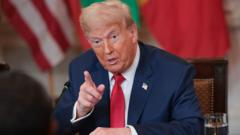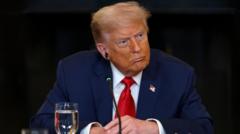In a rare investigation, access to a drug cartel's operation exposes the chilling efficiency of fentanyl trafficking from Mexico to the U.S. The illicit trade persists despite tariffs and political promises, while the devastating impact on American society continues to rise.
Tracing Fentanyl's Path from Mexican Cartels to U.S. Streets

Tracing Fentanyl's Path from Mexican Cartels to U.S. Streets
As the fentanyl crisis escalates, a report explores the drug's journey from Mexican cartels to American communities, revealing the stark realities behind this transnational epidemic.
In the shadowy world of drug trafficking, one substance remains at the epicenter of a burgeoning crisis: fentanyl. A dealer known only as Jay, operating from Los Angeles, reveals the grim reality of this synthetic opioid's journey from a cartel-controlled safe house in Mexico to the streets of the U.S. As clandestine operations unfold, Narco culture thrives, thriving on the insatiable demand for drugs.
At the safe house, Jay observes as cartel operatives carefully prepare his latest shipment of fentanyl, sealing the potent pills into a car's gas tank to elude customs enforcement. Amidst the talk of drug smuggling, he reflects on the ongoing demand for fentanyl in the U.S., stating, "There's always going to be a demand. And where's the biggest demand? United States, lucky for us." The trade flourishes, with Jay procuring 100,000 pills weekly before selling them at a fraction of last year's prices, suggesting that economic pressures haven't hindered trafficking efforts.
The Biden administration's pushback against this illicit flow has included expansive tariffs on goods from Mexico, as President Donald Trump previously declared a "war" on drug traffickers. Despite these political maneuvers, Jay is skeptical of any substantial change. He accurately points to the historical failures of past administrations in curbing the crisis, observing that the root of the problem lies in the U.S.'s unchecked demand for narcotics.
An alarming aspect of the fentanyl crisis is its role in rising overdose fatalities. While recent data shows a slight decline in opioid-related deaths, the impact remains devastating, with an estimated 87,000 overdose deaths reported over the last year. Fentanyl, being 50 times more potent than heroin, poses a significant risk, and the continuing flow of the drug exacerbates the issue.
In a bid to contain the crisis, Mexico's President Claudia Sheinbaum announced the deployment of 10,000 National Guard troops to the border, as well as cooperation with U.S. intelligence agencies to monitor cartel activities. Arrests have significantly increased, and the country has reported substantial seizures of fentanyl, suggesting at least some government action against the cartels.
Yet, as American drug enforcement struggles to tackle the issue, the profound human cost emerges. Activists like Rosalind Pichardo highlight the devastation in communities battered by the fentanyl epidemic, documenting each life saved through the use of Naloxone, which reverses opioid overdoses. Operating in Philadelphia's Kensington neighborhood, Pichardo makes it clear that the need for sustained support initiatives is as crucial as policy changes.
She argues that even if the flow of fentanyl from Mexico were to cease, the addiction crisis in American neighborhoods would not necessarily improve. "Once there was heroin, now there's fentanyl. When there's no fentanyl, now it's going to be Xylazine," she states, reflecting the cyclical nature of drug dependence.
As stories of individuals grapple with addiction continue to surface, the growing consensus is clear: a multifaceted strategy addressing both supply and demand is essential in combating the fentanyl crisis. Until then, the deadly cycle of drug trafficking and addiction remains alarmingly entrenched within both Mexico and the United States.




















